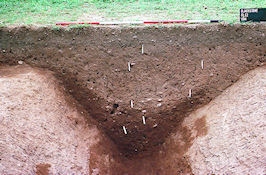
Figure 23: Outer enclosure ditch 1014, view of section (north-facing) near butt end on south side of entrance (see also Fig. 24).
Commentary on the Site Description (2008)
The outer ditch was sectioned at six points (1013, 1014 (Figs. 23-4), 0600, 0307, 1548 and 0604 clockwise from gateway area; Figs. 9, 11, 14, and 33), but two of the sections (0600 and 0604) were fairly uninformative because of very dry conditions in the 1972 season, which left only four useful cuttings. The average width of the ditch was 2.81m, and its average depth 1.19m. Thus, it was generally a little shallower than the inner ditch and gave an overall impression of slighter construction. The ditch was interrupted at the same place as the inner ditch by an entrance causeway of the same width (6m).

Figure 23: Outer enclosure ditch 1014, view of section (north-facing) near butt end on south side of entrance (see also Fig. 24).
Cuttings 1013 and 1014 (Figs. 9 and 23-4) present a different picture from the cuttings across the southern arm of the ditch, particularly 0307 and 1548 (Figs. 11 and 14 respectively). The recuts clearly evidenced in 0307 and 1548 were not visible in 1013 (none illustrated) and 1014 (Fig. 24). Basal slots in 0307 and 1548 probably represent fairly conscientious maintenance with one lapse, which occasioned the main recut (0307.4 and 1548.20). The ditch terminals 1013 and 1014 are wider and deeper, presumably because they were cleaned out more thoroughly. The last of the recuts or clean-outs here may thus have been very drastic, removing all previous fills, and deepening and rounding the original profile. Alternatively, regular maintenance might have the same effect. The fills in these ditch cuttings tended to be fairly uniform, and may well be the result of natural silting processes after abandonment of the ditch, if not indeed of the entire enclosure complex.
A tendency for fills to derive from the inner edge of the outer ditch suggests an inner earthen bank. There is a zone of animal/root holes comparable to that behind the inner ditch. It has, however, been suggested that the second (Period 3.3) palisade in the inner ditch must have been earth-braced. It was, therefore, suggested that the material for this bracing was upcast from the excavation of the outer ditch. The Period 3.3 defences were defined by the later palisade supported by an earthen bank, with the (outer) ditch in front of it, with a berm now between ditch and palisade, as the volume of material excavated from the outer ditch was inadequate to both support the palisade and fill the 4–5m wide space between it and the outer ditch. Since the palisade would require soil and gravel to be piled as high as possible around its foot to ensure stability, the earth bank would have to be high rather then wide and a substantial berm between the palisade and the outer ditch would inevitably result. Later cleaning and recutting of the outer ditch would have produced upcast which, if deposited on this berm, would have obscured it and perhaps produced an additional low bank here. The presence of such a bank would help to explain the animal and root disturbances in the berm area, and could also account for the indications, in the outer ditch sections, of preferential silting from the inside edge.
The outer ditch followed the line of the inner ditch fairly accurately except for the length between grid points K3 and K5 (Fig. 11). Here the outer ditch was kinked sharply outward and the distance between the ditches increased from an average of c. 4.5m, to c. 8m in this limited area. The kink seems too drastic to be the result of misalignments resulting from gang digging, and was presumably deliberate.
The chronological relationship of the inner ditch to the outer ditch cannot be clearly demonstrated, but two arguments can be advanced to suggest that the outer ditch was constructed later than the inner one. The first is based on the following evidence (see also above):
The second argument is based upon the observation that the inner ditch respected, and was respected by, the internal features of the enclosure (e.g. the inner annexe) and so was likely to be the original enclosure ditch. This would also allow the contemporaneity of the two ditches, and at least shows that the inner is not later than the outer.
These arguments were neither supported nor refuted by the distribution and dating of artefacts, since the pottery (the only potentially datable material recovered from the ditches) was essentially of similar character in all these contexts (but see Prehistoric pottery section, where 2007–8 analysis notes that the latest Iron Age sherds are from the upper fills of the outer ditch).
© Internet Archaeology/Author(s)
URL: http://intarch.ac.uk/journal/issue28/3/3.2.3.8.html
Last updated: Wed July 21 2010